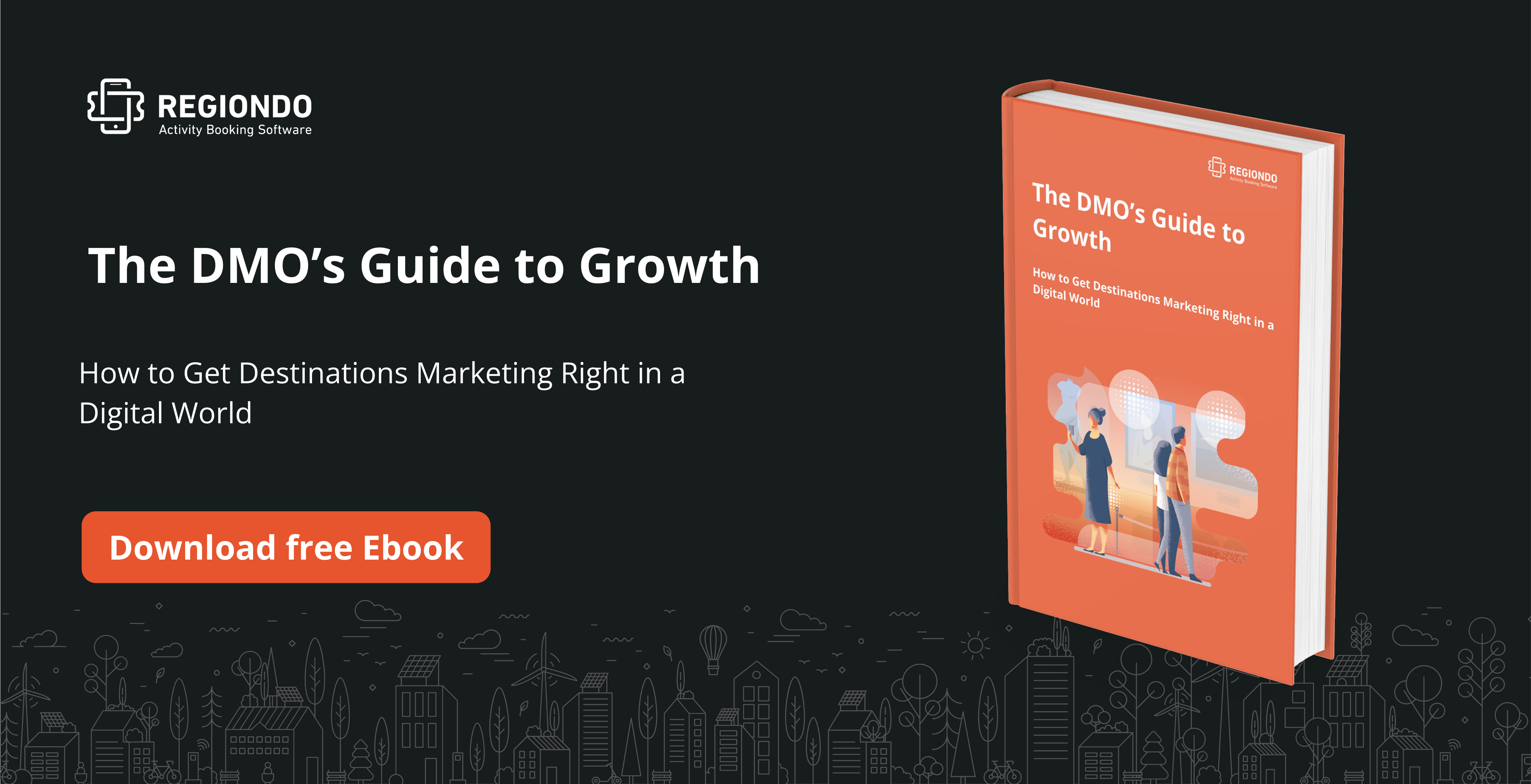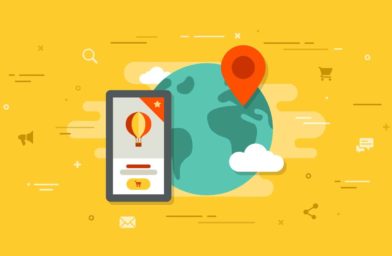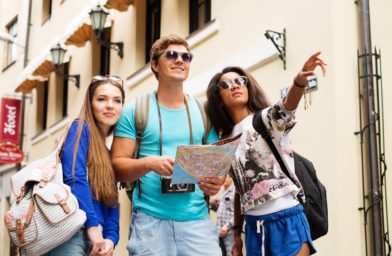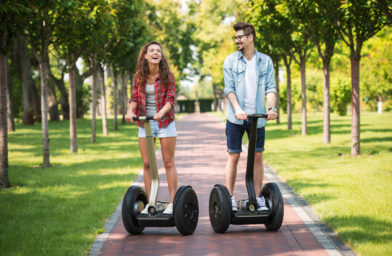We currently live in an experience economy and travel is the ultimate experience, wouldn’t you agree? That’s why the travel and tourism industry is set to be one of the biggest and most lucrative industries, globally.
According to the World Travel and Tourism Council (WTTC), travel and tourism grew by 3.9 percent in 2018; generates $8.8 trillion in revenue; and created 319 million jobs.
Those are some pretty big stats.
In order to compete in such a growing and lucrative industry, you need a rockstar marketing strategy. A strategy to get more eyes on your brand, and consequently, more customers.
That’s what we want to share with you in this article: the most up-to-date marketing strategies for tour and activity providers.
What’s a Marketing Strategy?
Before we begin, it’s important to make a distinction between a marketing strategy and a marketing tactic. (As we will strictly be covering marketing strategies in this article.)
A marketing strategy is essentially an overarching plan to achieve one’s marketing goals and objectives. In plain terms, it is a plan which guarantees that your marketing tactics are constantly contributing to your business goals.
Tactics, on the other hand, consist of highly practical marketing activities that you do every day. For example, posting to social media, writing blog posts, sending emails, etc.
That distinction is quite important. In this article, we will cover the top tourism marketing strategies for tour and activity providers.
14 Tourism Marketing Strategies to Help You Succeed in 2021 and Beyond
1. Understand Your Customers
The first thing you need to do is to understand your ideal customers.
You need to know their demographic information; as well as what drives them to book and how they prefer to book. Questions to ask yourself during this brainstorming session are: What motivates them [your ideal customer] to travel? Where do they find information about their destination? How do they prefer to book? What annoys them about the research and booking process?
You can build at least 3 customer personas from your answers to those questions. You can then develop your branding, website and marketing strategy around the personas.
Keep your unique selling point and what drives you as a business in mind. You’ll need to convey that in an appealing way to reach your customers on a more personal level.
2. Optimize Your Website
Your website is the foundation for all your internet marketing efforts. As such, you should optimize it frequently to improve user experience and boost your conversion rates.
If your site performs poorly on mobile, is cluttered, too slow, or just too old, you definitely need to optimize it. You can test your site performance and speed with SEO Grader tool.
Perhaps you already do all that and your site is well-designed and well-functioning. But is it optimized for clicks and conversions? In that case, it may be a good idea to call in an expert (with industry knowledge) to help you make the right optimizations.
3. Focus on Mobile
According to Think with Google, 48 percent of US smartphone users are comfortable researching, planning and booking their entire trip on their mobile devices. The stats are similar in Europe: 45 percent of UK travelers and 44 percent of French travelers are comfortable planning and booking their entire trip on their mobile devices.
What does this tell us?
That the mobile experience should be as good as the website experience, if not better. Users need to be able to perform the same tasks, as comfortably, on their mobile devices as they can on the desktop version of your website.
To highlight the importance of the mobile experience, the same Think with Google study found that 33 percent of mobile users have a negative perception of a brand if their mobile experience is slow.
That says a lot.
4. Be Social
Social media is one of the most effective marketing channels for the tourism industry. That’s if you choose the right platform (where your customers are) and set up a strategy for each platform.
Facebook is perhaps the best social media platform for tour and activity providers, in terms of driving traffic to a website. It’s a crowded social network but you can find your tribe by using specific targeting and advertising. Here’s a detailed guide to rocking it on Facebook.
Instagram has one billion monthly active users. That’s a lot of people to get your brand in front of. Additionally, Instagram is a purely visual platform which makes it the perfect medium to market a destination.
Instagram launched IGTV in 2018 to host vertical long-term video content on mobile devices. The platform has experienced tremendous growth since its launch, as marketers and brands have become increasingly reliant on mobile video content to boost engagement metrics and conversion rates.
5. Live Video Marketing
Video marketing is king right now, especially for brands in the tourism sector. Travelers are frequently searching for videos of destinations they want to travel to. The problem is that they no longer want just pre-recorded videos.
Live streaming videos are getting more and more popular. Your potential customers probably love watching them (research shows that 82 percent of people prefer to watch live videos over social media posts); while you get to lower your video production costs and show your authenticity as a brand.
Let’s take a look at a brand that gets live video streaming right: Hotel del Coronado in San Diego. They have a 24/7 live beachcam to show customers the beach fun they’re missing out on. They simply set up a camera and put on a live feed.
6. Send Those Emails
Your email list is the only (and most valuable) marketing asset you own. It is more powerful than other marketing strategies: It converts better than both social and search.
So if you don’t have an active email list, you need to start building one. You should ideally have a subscription form on your website to invite website visitors into your inner online community. From there, you can connect with them again and convert them into paying customers.
Here are the ins and outs of email marketing for tour and activity providers.
7. Accept Online Bookings
According to Zion Market Research, the online travel booking market was worth 765 billion USD in 2017 and is expected to generate 1,955 billion USD by 2026. In addition to that, over 57 percent of all travel reservations (including accommodation, tours and activities, flights, etc.) are made online.
Travelers have a lot of online resources and tools at hand to research, review deals, and choose the best travel deals for them. If you want yours to be one of the travel deals they book, you need to meet them where they are: they’re booking travel deals online so you need to facilitate online bookings on your website.
To start getting bookings online, you’ll need a booking system embedded to your website. Try Regiondo – it’s the most popular booking system in Europe that lets you grow your revenue and automate everyday reservation tasks. Book a demo and our experts will guide you through the platform and answer all your questions.
8. Tap into The Power of Reviews
Review sites like Yelp, TripAdvisor, and Google Local are perfect for building up an online presence and reputation.
Consider getting on one, or a couple of notable ones. Make sure to respond to all reviews – both negative and positive – to acknowledge that you’re listening and hearing every single feedback.
Reviews not only increase consumer confidence in your brand and products, but user-generated content, in general, can help boost your website ranking and conversion rates.
9. Blog, Consistently
Your customers want to hear from you. They want knowledge and insights from you, i.e. a blog. Blogging is a good way to tell stories, share unique insights about the destination, share travel tips, etc.
It’s also a good way to reel in your audience and advertise your expertise in the field. If you do not currently have a blog, create one and blog on a consistent schedule.
10. Get SEO Right
SEO is more important today for tour and activity providers than ever before.
A typical traveler’s journey today starts with Google. Tourists use search engines to research destinations, accommodation, transport, activities and tours, etc. If your offerings are not on the first page of search results, you don’t exist to a potential customer.
In fact, people joke that the best place to hide corpses is on the second page of Google search results because no one ever goes there.
So it’s important to show up in the top search results pertaining to your brand and offerings.
However, competition is high.
It’s not easy to rank on the first page of search engine results for many popular travel keywords. However, the effort is worth it because ranking high in Google search results for a specific keyword is better than running a Facebook ad or a TV commercial.
That is because people don’t use Facebook to buy products or services. However, when they search for specific products and services on Google, they often have an intent to purchase that product or service.
So, if they search for tours and activities in a destination you’re in, they are highly likely to book from you if you show up in the top results. You can check your SEO performance and keywords you are ranking for with our free SEO grader tool.
Cosmos, a tour operation company in Italy does SEO really well. They even show up in the top search results for the “tours in Italy” keyword on Google.
11. Set Up or Optimize Your “Google My Business” Listing
Speaking of SEO, Google My Business is a good place to start your SEO efforts, particularly local SEO.
For those unfamiliar with Google My Business (GMB), it is a free tool that enables you to control how your business shows up on Google Search and Google Maps. It specifically enables you to add your business name, contact details, location, hours, photos, etc. You can also monitor and respond to customer reviews, and see where and how people are searching for you.
And when people search for tours and activities near them, they’re usually ready to book the tour on that same day. Therefore, it’s important to create and optimize your GMB listing.
12. Focus on Experience
As mentioned earlier, we live in an experience economy and thus, in an era of experiential marketing. Experiential marketing is basically marketing that allows customers to experience your brand as opposed to you marketing your tours and offerings to a broad audience.
It’s also known as engagement marketing and it enables people to interact with brands one-on-one. Brands use physical branded materials to show customers what they offer and what they are all about on a more personal level.
You guessed it, it’s millennials that brought about experiential marketing; and at this rate, it’s only growing bigger. And it’s not only millennials that respond well to experiential marketing, older consumers do too.
Let’s take a look at an example of good experiential marketing: Travel Wisconsin. Travel Wisconsin ran a campaign to help potential tourists to imagine themselves doing various activities around Wisconsin. They used a funhouse mirror with local activities like tubing, and placed the activity in areas where people would be waiting, e.g. bus stops.
As you can see, experiential marketing is very different from traditional marketing strategies. Instead of spreading your message through traditional marketing tactics like print ads or commercials – messages that people don’t want to see or hear – you’re allowing people to interact with your brand in a fun way.
And guess what? Those are experiences people don’t want to miss out on.
13. Engage Micro-Influencers
Micro-Influencer marketing really came to the forefront last year and is still rising today. An increasing number of brands are relying on influencers with smaller and more targeted audiences (versus influencers with larger and broader audiences) to market their products or services.
Micro-influencers usually have 1,000-1,000,000 followers and specialize in a specific niche within their industry. As such, they often have higher engagement, more loyal followers, and better conversions on their social channels. Plus, they are cheaper than the big influencers.
14. Set Goals, Monitor and Optimize
When you begin executing some of these marketing strategies, you may notice sudden changes in your business. Those changes are a result of you getting to know your audience better and knowing which marketing strategies work best for you.
For example, you’ll know the types of blog posts your ideal customers like, whether they are responding well to your social strategy, and how they feel about your tour offerings and brand (via reviews).
You need to assess and analyze that data/feedback, and then make the appropriate changes to your marketing strategy.
For example, if a certain type of blog post is doing far better than other post types, consistently, then you should probably publish that type of post every week. Or perhaps you have many followers on Facebook but few on Twitter…you should review your social media strategy and make optimizations.
Conclusion
Those are the top tourism marketing strategies to consider implementing this year and beyond.
If the strategies in this post are executed correctly, you’ll get considerable results in terms of overall sales.







